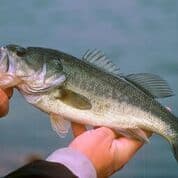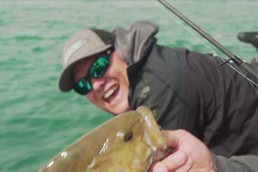Night Fishing for Largemouth Bass on Cedar Lake
SHARE THIS POST

This reservoir near Carbondale is actually the water supply for the community, but a lack of development on Cedar Lake and rugged good looks of its shoreline makes for a calming nighttime fishing experience.
Although the northern half of the shoreline belongs to the City of Carbondale, the rest of the lies within the Shawnee National Forest and property of the U.S. Forest Service, and is under a reciprocal agreement with the owners the Illinois DNR, which manages the fishery.
Cedar Lake is 1,750 acres and six miles south of Carbondale via Highway 51. It has 40 miles of shoreline and a maximum depth of 60 feet with largemouths, spotted bass, bluegills, sunfish, crappies, channel catfish, bullhead, carp, walleyes, yellow bass, sucker and drum. Largemouth bass are the fish of choice for the trophy angler setting forth at night.
Recently, the IDNR has been stocking striped bass in alternating years. Anglers reportedly catch fish up to 20 pounds, and those in pursuit of largemouths catch many.
The unspoiled shorelines contain stands of American beech, red cedar, hickory, elm, dogwood and pine. The trees help prevent erosion, keeping the lake clear and clean. A 10-hp limit on boat motors contributes to the lack of shoreline erosion. There are other site-specific regulations, which are posted at the boat ramp and available through the IDNR and Forest Service offices. Kayaks and canoes are popular, but site-specific regulations do not allow houseboats, pontoons and water skiing.
The lack of motorized traffic significantly reduces the night fishing danger of accidents found on other lakes. Still, it is a good idea to have a light available in case another boat approaches. A map of the lake may come in handy, as it is possible to get into one of the many coves without realizing you are off the main channel.
As the waters begin to warm at the beginning of summer, so does the fishing pressure. The number of fishermen on the water increases, as does the number of bank fishermen.
Surface water temperatures rise into the 50s and 60s with deeper water running 20 degrees lower—ideal for fish. The oxygen in the water is consistent from top to bottom, causing fish to explore the entire range. During the summer thermocline, about 16 feet, they stay in the top 10 feet. Local anglers concentrate on wood structure like stumps, deadfalls, beaver houses or brush piles. If you find them in less than 10 feet of water on the main lake, they are worth exploring.
Are you enjoying this post?
You can be among the first to get the latest info on where to go, what to use and how to use it!
There are a number of artificial fish attractors thanks to Shawn Hirst, a fisheries manager for the IDNR. A number of volunteers helped to place them in the lake. Hirst placed some 30 permanent locators in groups of 10 to 13, with the greater number put in deeper. He says the shallow-water structure is abundant in the lake, so there is a need for deep-water structure. In spring and fall, the fish are on the shallow-water structure and need the deep water structure the rest of the year.
Maps of the GPS locations of all the locators are available in local bait shops, Lake Murphysboro State Park and by email shawn.hirst@illinois.gov.
The number of bass at 14 to 18 inches in the protected slot limit in recent surveys is the second lowest in the 8 years of the surveys. As a result, Hirst recommends that anglers keep their daily limit of five largemouths under 14 inches in length to aid in thinning out the smaller ones in the lake. This is done to increase growth rates, to allow more bass to reach the protected slot limit and to lead to more trophy-size fish in the future. At present, bass are over 18 inches in about 13 percent of the population. (The IDNR stocks threadfin shad into the lake when they are available as a supplemental forage base.)
Largemouth bass in shallow waters are best enticed with a spinnerbait. With the exception of the period during the full moon, bass feed using their lateral lines as a built-in kind of sonar. A steady retrieve of a spinnerbait will allow fish to hone in on the sound. You can enhance the bait with a white or yellow twister tail. During the full moon, largemouths strike on sight. Dark colors create a silhouette when seen from below.
Another pattern used often is to locate the mouth of a feeder stream and fish the vegetation on each side of it. A plastic worm rigged Texas-style in a dark color like purple or black works. Also, night fishing in warm weather means a pump-drop-pump-drop kind of presentation for spinnerbaits.
Fishing at night is a great way to catch some nice bass on Cedar Lake. Primitive camping is available in the Shawnee Forest section of the lake too. MWO
MWO
SHARE THIS POST
Did you enjoy this post?
You can be among the first to get the latest info on where to go, what to use and how to use it!
Don Gasaway
Don Gasaway is a veteran freelance outdoor writer from Marion, Ill. He may also be found at: https://www.facebook.com/DonGasawayWriter and facebook.com/Wandering Angler. Comments are welcome



